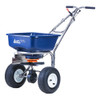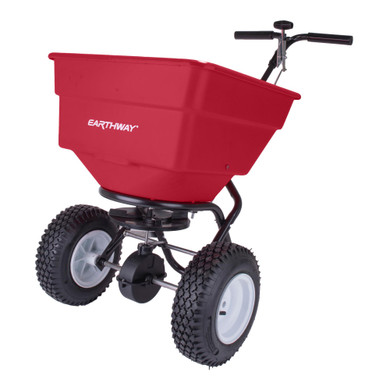Product details
ICL SR-2000 Rotary Broadcast Spreader
The SR-2000 Rotary Spreader has all the features of the AccuPro 2000 Rotary Spreader plus:
- Larger 139 Turf Saver 2 pneumatic wheels for an easier push
- New and improved larger diameter, more durable stainless steel frame
- Patented Helical Cone for a uniform, consistent spread pattern
- Extended handle with tuff-foam grips for added comfort
- Positive on-off deflector provides effective product delivery control
- Standard port shut-off control for greater application efficiency
Time invested in checking and setting spreaders is quickly recouped by better application accuracy, which prevents under or over-dosing and stripes in the sward caused by misses or overlaps.
Effective applications start with the end of the last job. Machines need to be thoroughly cleaned and, if possible, dried before they are put away. Fertilizer absorbs moisture from the air and if any is left in the spreader this will quickly corrode metal parts.
Before starting work, operators should give the applicator a thorough inspection: Ensure the rate setting mechanism is free and adjusts easily, check the on/off works and the distribution rotor or spinning discs are not worn and functioning properly.
It is vital to then set and test the machine with the actual fertilizer it will be applying. The bulk density of the material affects the spread pattern and flow rate. The same application rate will need fewer denser granules to flow through than less dense material, even though they could be the same physical size. Denser particles will be spread further – e.g. consider how far a cricket ball can be thrown compared with a tennis ball.
This is a very important consideration when setting pedestrian and tractor-mounted spinning disc spreaders, which rely on centrifugal force to achieve the spreading width, with larger, denser granules travelling further than lighter, less dense ones.
With these applicators it is crucial to check the distribution pattern, with a full-width tray test, as well as the rate calibration. This will ensure you know how much is being applied as well as ensure it is being spread evenly across the whole width.
There are four main spreaders used to apply fertilizer – pedestrian drop-style, pedestrian spinning disc, tractor-mounted spinning disc or oscillating spout. All have different calibration and settings procedures.
With pedestrian operated machines settings are usually made for a ‘normal walking pace’ of 5km/hr (3mph). It is important to maintain the speed for which the calibration settings have been made to prevent under or overdosing. Walking speed also influences the spread width on spinning disc applicators. Also keep spreaders parallel to the ground to maintain an even distribution.





















